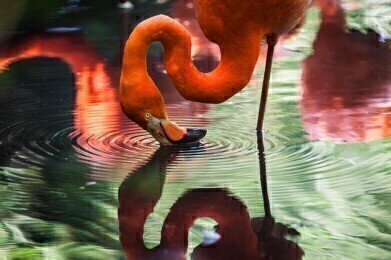Mass Spectrometry & Spectroscopy
Why Do Flamingos Stand on One Leg?
Jun 16 2017
When it comes to balance, flamingos have more or less perfected the art of standing on one leg. Tall, feathery and shockingly pink, they definitely know how to stroke a pose. And now, scientists are maintaining that they’ve discovered why the wading birds continually revert to their iconic one-legged stance.
Apparently, it’s all about conserving energy. Unlike most of the animal kingdom, flamingos use less energy standing on one leg. Together, Professor Young-Hui Chang of the Georgia Institute of Technology and Dr Lena H Ting of Emory University found that flamingos are equipped with a leg mechanism that locks into place when straightened. This allows them to remain perfectly balanced, without expending any muscular activity.
The leg lock phenomenon
Studying a pair of donated flamingo corpses from Birmingham Zoo, Chang and Ting began to manipulate limbs. At one point, Chang picked up one of the birds by its leg and flipped it upright. Amazingly, the leg locked into place and held up the corpse.
“That was the ‘Aha!’ moment when we knew we were on to something special,” recalls Chang in an interview with Discover. “If a dead flamingo could do it, then it is probably available for live birds to do.”
Strangely, they also discovered that dead flamingos weren’t able to hold the pose when standing on two legs. This led them to conclude that flamingos exert more effort using two legs, as opposed to one.
An energy efficient passive support mechanism
After homing in on the leg lock phenomenon, they then studied the balance behaviours of eight juvenile flamingos housed at Zoo Atlanta. Each flamingo was placed on a set of force-plate scales until they fell asleep. When dozing, postural sway was seven times lower than in an active state.
The results were published in the journal Biology Letters, and suggest that flamingos rely on a passive support mechanism, as opposed to an active one that calls for muscular exertion. While it seems counterintuitive, for flamingos locking one leg into place is a far more energy efficient way to remain dormant.
Beyond a greater understanding of flamingo biomechanics, Chang and Ting maintain that the findings could have practical applications, like inspiring the development of multi-legged robots and prosthetic limbs.
Studies like this can unveil fascinating insight into the six kingdoms. Flamingos aren’t the only organisms in the spotlight, with ‘Leaf Polyphenols as Indicators of Climatic Adaptation of Beech (Fagus sylvatica L.) – an HPLC-MS/MS via MRM Approach’ exploring the chemical defence mechanisms of certain trees growing in temperate zone forests.
Digital Edition
Lab Asia 31.2 April 2024
April 2024
In This Edition Chromatography Articles - Approaches to troubleshooting an SPE method for the analysis of oligonucleotides (pt i) - High-precision liquid flow processes demand full fluidic c...
View all digital editions
Events
Apr 22 2024 Marrakech, Morroco
Making Pharmaceuticals Exhibition & Conference
Apr 23 2024 Coventry, UK
Apr 23 2024 Kintex, South Korea
Apr 23 2024 Seoul, South Korea
Apr 24 2024 Jakarta, Indonesia













.jpg)




